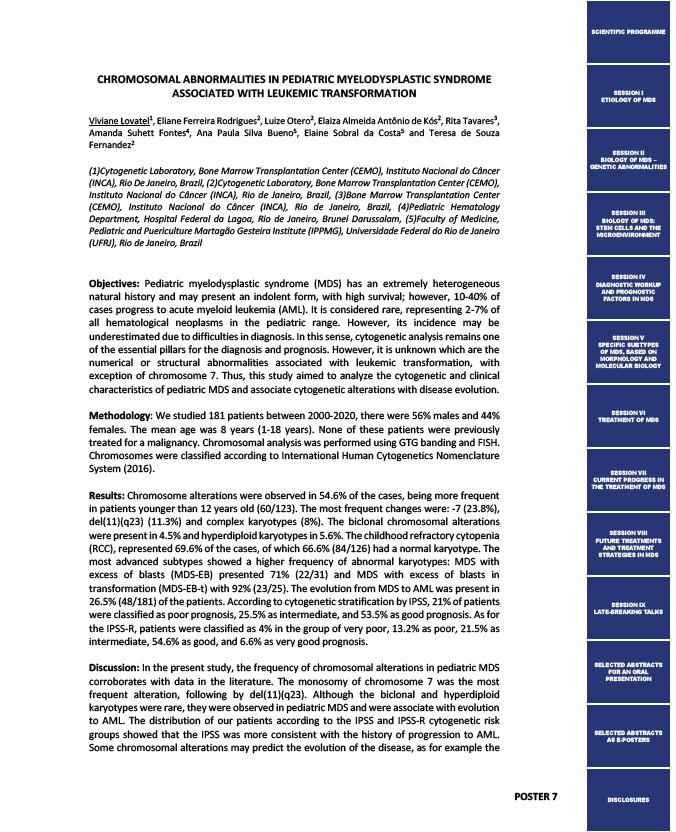
CHROMOSOMAL ABNORMALITIES IN PEDIATRIC MYELODYSPLASTIC SYNDROME
ASSOCIATED WITH LEUKEMIC TRANSFORMATION
Viviane Lovatel1, Eliane Ferreira Rodrigues2, Luize Otero2, Elaiza Almeida Antônio de Kós2, Rita Tavares3,
Amanda Suhett Fontes4, Ana Paula Silva Bueno5, Elaine Sobral da Costa5 and Teresa de Souza
Fernandez2
(1)Cytogenetic Laboratory, Bone Marrow Transplantation Center (CEMO), Instituto Nacional do Câncer
(INCA), Rio De Janeiro, Brazil, (2)Cytogenetic Laboratory, Bone Marrow Transplantation Center (CEMO),
Instituto Nacional do Câncer (INCA), Rio de Janeiro, Brazil, (3)Bone Marrow Transplantation Center
(CEMO), Instituto Nacional do Câncer (INCA), Rio de Janeiro, Brazil, (4)Pediatric Hematology
Department, Hospital Federal da Lagoa, Rio de Janeiro, Brunei Darussalam, (5)Faculty of Medicine,
Pediatric and Puericulture Martagão Gesteira Institute (IPPMG), Universidade Federal do Rio de Janeiro
(UFRJ), Rio de Janeiro, Brazil
Objectives: Pediatric myelodysplastic syndrome (MDS) has an extremely heterogeneous
natural history and may present an indolent form, with high survival; however, 10-40% of
cases progress to acute myeloid leukemia (AML). It is considered rare, representing 2-7% of
all hematological neoplasms in the pediatric range. However, its incidence may be
underestimated due to difficulties in diagnosis. In this sense, cytogenetic analysis remains one
of the essential pillars for the diagnosis and prognosis. However, it is unknown which are the
numerical or structural abnormalities associated with leukemic transformation, with
exception of chromosome 7. Thus, this study aimed to analyze the cytogenetic and clinical
characteristics of pediatric MDS and associate cytogenetic alterations with disease evolution.
Methodology: We studied 181 patients between 2000-2020, there were 56% males and 44%
females. The mean age was 8 years (1-18 years). None of these patients were previously
treated for a malignancy. Chromosomal analysis was performed using GTG banding and FISH.
Chromosomes were classified according to International Human Cytogenetics Nomenclature
System (2016).
Results: Chromosome alterations were observed in 54.6% of the cases, being more frequent
in patients younger than 12 years old (60/123). The most frequent changes were: -7 (23.8%),
del(11)(q23) (11.3%) and complex karyotypes (8%). The biclonal chromosomal alterations
were present in 4.5% and hyperdiploid karyotypes in 5.6%. The childhood refractory cytopenia
(RCC), represented 69.6% of the cases, of which 66.6% (84/126) had a normal karyotype. The
most advanced subtypes showed a higher frequency of abnormal karyotypes: MDS with
excess of blasts (MDS-EB) presented 71% (22/31) and MDS with excess of blasts in
transformation (MDS-EB-t) with 92% (23/25). The evolution from MDS to AML was present in
26.5% (48/181) of the patients. According to cytogenetic stratification by IPSS, 21% of patients
were classified as poor prognosis, 25.5% as intermediate, and 53.5% as good prognosis. As for
the IPSS-R, patients were classified as 4% in the group of very poor, 13.2% as poor, 21.5% as
intermediate, 54.6% as good, and 6.6% as very good prognosis.
Discussion: In the present study, the frequency of chromosomal alterations in pediatric MDS
corroborates with data in the literature. The monosomy of chromosome 7 was the most
frequent alteration, following by del(11)(q23). Although the biclonal and hyperdiploid
karyotypes were rare, they were observed in pediatric MDS and were associate with evolution
to AML. The distribution of our patients according to the IPSS and IPSS-R cytogenetic risk
groups showed that the IPSS was more consistent with the history of progression to AML.
Some chromosomal alterations may predict the evolution of the disease, as for example the
POSTER 7
SCIENTIFIC PROGRAMME
SESSION I
ETIOLOGY OF MDS
SESSION II
BIOLOGY OF MDS –
GENETIC ABNORMALITIES
SESSION III
BIOLOGY OF MDS:
STEM CELLS AND THE
MICROENVIRONMENT
SESSION IV
DIAGNOSTIC WORKUP
AND PROGNOSTIC
FACTORS IN MDS
SESSION V
SPECIFIC SUBTYPES
OF MDS, BASED ON
MORPHOLOGY AND
MOLECULAR BIOLOGY
SESSION VI
TREATMENT OF MDS
SESSION VII
CURRENT PROGRESS IN
THE TREATMENT OF MDS
SESSION VIII
FUTURE TREATMENTS
AND TREATMENT
STRATEGIES IN MDS
SESSION IX
LATE-BREAKING TALKS
SELECTED ABSTRACTS
FOR AN ORAL
PRESENTATION
SELECTED ABSTRACTS
AS E-POSTERS
DISCLOSURES